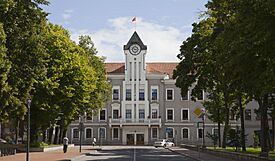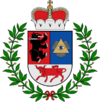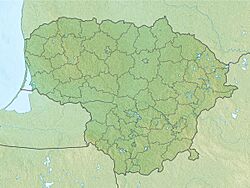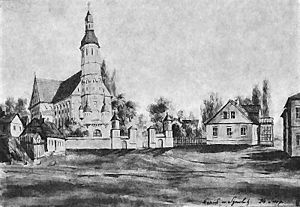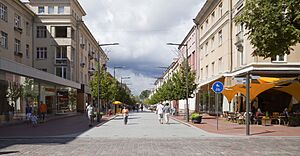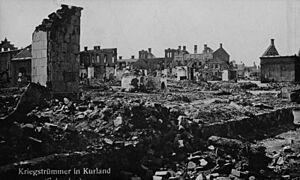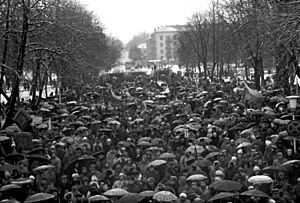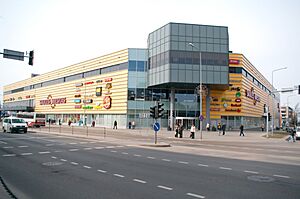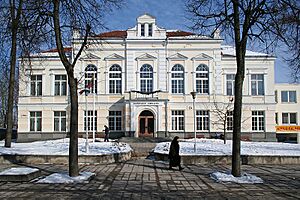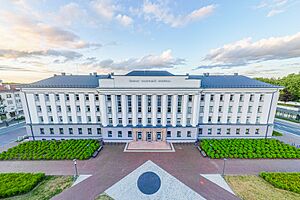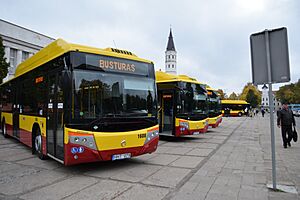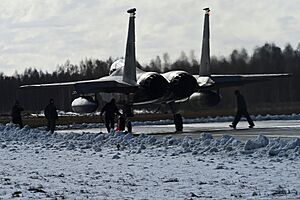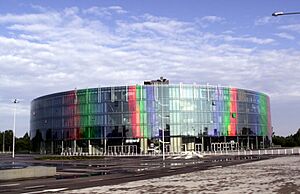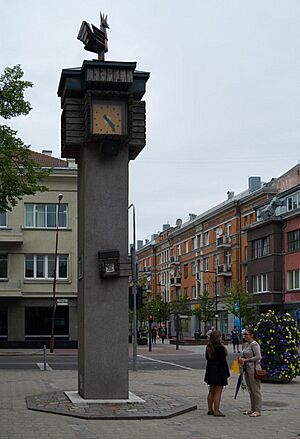Šiauliai facts for kids
Quick facts for kids
Šiauliai
|
|||
|---|---|---|---|
|
City municipality
|
|||
|
|||
|
|||
| Nickname(s):
Saulės miestas (The City of the Sun)
|
|||
| Country | Lithuania | ||
| Ethnographic region | Samogitia | ||
| County | Šiauliai County | ||
| Municipality | Šiauliai city municipality | ||
| Capital of | Šiauliai County Šiauliai city municipality Šiauliai district municipality |
||
| First mentioned | 1236 | ||
| Granted city rights | 1589 | ||
| Elderships | Medelynas eldership, Rėkyva eldership | ||
| Area | |||
| • City municipality | 81.13 km2 (31.32 sq mi) | ||
| Elevation | 151 m (495 ft) | ||
| Population
(2024)
|
|||
| • City municipality | 112,581 | ||
| • Density | 1,387.66/km2 (3,594.03/sq mi) | ||
| • Metro | 140,379 | ||
| Time zone | UTC+2 (EET) | ||
| • Summer (DST) | UTC+3 (EEST) | ||
| Postal code |
76xxx
|
||
| Area code(s) | (+370) 41 | ||
| Climate | Dfb | ||
Šiauliai is a lively city in northern Lithuania. It's the fourth largest city in Lithuania and the sixth largest in the Baltic States. In 2024, about 112,581 people lived here. From 1994 to 2010, Šiauliai was the main city of Šiauliai County.
Contents
History of Šiauliai
The city was first written about as Soule in 1236. This was in the records of the Livonian Order, describing the Battle of Saule. This battle happened near Šiauliai on September 22, 1236. So, this date is considered the city's founding day.
At first, Šiauliai was a defense spot. It protected against attacks from the Teutonic Knights and Livonian Order. After the Battle of Grunwald in 1410, the attacks stopped. Šiauliai then grew as a farming town. A wooden church was built in 1445. It was replaced by a brick church in 1625, which you can still see today.
Šiauliai gained Magdeburg rights in the 16th century. This meant it could govern itself and became an important center. However, from the 16th to 18th centuries, the city faced many challenges. It was badly damaged by a great flood and widespread diseases.
Rebuilding the City
Antoni Tyzenhaus helped the city recover. After a peasant uprising in 1769, he started big changes. He decided to rebuild Šiauliai with a new plan. Instead of random streets, he made a neat, rectangular grid. Šiauliai became a well-developed city with many strong brick buildings.
In 1791, King Stanisław August Poniatowski confirmed Šiauliai's city rights. He also gave it a coat of arms. This coat of arms showed a bear, which stood for Samogitia. It also had the Eye of Providence and a red bull, a symbol of the Poniatowski family. Today's coat of arms looks similar to this old design.
After the Partitions of Poland, Šiauliai got a new coat of arms. The city grew and became a key place for learning and culture. Its transport system also improved quickly. A road connecting Riga and Tilsit was built from 1836 to 1858. In 1871, a railroad linked Liepāja with Romny. Šiauliai was at a crossroads of important trade routes. This helped it become an industrial town. By 1897, it was the third-largest city in Lithuania. It had about 16,000 people. Many Jewish people lived there; in 1909, 56.4% of residents were Jewish. Šiauliai was famous for its leather industry. Chaim Frenkel owned the biggest leather factory in the Russian Empire.
World War I and Independence
During World War I, about 85% of the city's buildings were destroyed. The city center was ruined. After the war, Lithuania became independent again. Šiauliai's importance grew. It was the second-largest city in Lithuania after Kaunas. By 1929, the city center was rebuilt. Modern services were added, like streetlights and public transport. There were also telephone lines, water pipes, and sewers.
The first years of independence were hard for the city's industries. They lost their markets in Russia. So, they had to find new customers in Western Europe. In 1932, a railroad to Klaipėda was built. This connected Šiauliai to Western markets. By 1938, the city made about 85% of Lithuania's leather. It also produced 60% of footwear and 75% of flax fiber. Culture also thrived. Many new newspapers were printed. New schools and universities opened. A library, theater, and museum were also established.
World War II Impact
During World War II, Šiauliai faced great challenges. In 1939, about one-fifth of the city's population was Jewish. German soldiers entered Šiauliai on June 26, 1941. The Šiauliai Ghetto was created in July 1941. The Jewish population in Šiauliai was greatly reduced during this time. About 80% of the city's buildings were destroyed during the war.
Soviet Era and Rebuilding
After the war, during the Soviet occupation, the city was largely rebuilt. It was designed in a typical Soviet style.
Geography and Climate
Šiauliai is located in the eastern part of a northern plateau. The Mūša, Dubysa, and Venta Rivers flow through the area. It is about 210 kilometers from Vilnius. Kaunas is 142 kilometers away. Klaipėda is 161 kilometers away. Riga is 128 kilometers away, and Kaliningrad is 250 kilometers away.
The total area of the city is 81.13 square kilometers. Green areas cover 18.87 square kilometers. Water bodies cover 12.78 square kilometers.
Water Bodies
Šiauliai has a total water area of 1,280 hectares. This makes up 15.7% of the city's area.
- Šiauliai Lakes
- Rėkyva Lake, 1,179 ha
- Talkša Lake, 56.2 ha
- Ginkūnai Lake, 16.6 ha
- Rivers
- Kulpė
- Rūdė
- Vijolė
- Švedė
- Šimša
- Tilžė
- Šventupis
Climate in Šiauliai
Šiauliai has a warm-summer humid continental climate. This means it has warm summers and cold winters. The average temperature in January is about -3°C. In July, the average temperature is around +18°C. The city gets about 620 millimeters of rain each year. In 1942, Šiauliai recorded the lowest average yearly temperature in Lithuania, which was +3.6°C.
| Climate data for Šiauliai (1991–2020 normals, extremes 1937-present) | |||||||||||||
|---|---|---|---|---|---|---|---|---|---|---|---|---|---|
| Month | Jan | Feb | Mar | Apr | May | Jun | Jul | Aug | Sep | Oct | Nov | Dec | Year |
| Record high °C (°F) | 10.5 (50.9) |
13.3 (55.9) |
21.0 (69.8) |
26.6 (79.9) |
30.4 (86.7) |
32.1 (89.8) |
35.0 (95.0) |
35.7 (96.3) |
30.1 (86.2) |
23.3 (73.9) |
16.9 (62.4) |
13.4 (56.1) |
35.7 (96.3) |
| Mean maximum °C (°F) | 5.9 (42.6) |
6.2 (43.2) |
12.9 (55.2) |
21.9 (71.4) |
26.3 (79.3) |
28.2 (82.8) |
30.2 (86.4) |
29.6 (85.3) |
24.1 (75.4) |
17.7 (63.9) |
10.9 (51.6) |
6.6 (43.9) |
31.4 (88.5) |
| Mean daily maximum °C (°F) | −0.4 (31.3) |
−0.1 (31.8) |
4.7 (40.5) |
12.4 (54.3) |
17.9 (64.2) |
21.2 (70.2) |
23.6 (74.5) |
22.9 (73.2) |
17.3 (63.1) |
10.7 (51.3) |
4.5 (40.1) |
0.8 (33.4) |
11.4 (52.5) |
| Daily mean °C (°F) | −2.5 (27.5) |
−2.9 (26.8) |
1.1 (34.0) |
7.4 (45.3) |
12.4 (54.3) |
16.0 (60.8) |
18.5 (65.3) |
17.9 (64.2) |
13.0 (55.4) |
7.6 (45.7) |
2.4 (36.3) |
−1.2 (29.8) |
7.6 (45.7) |
| Mean daily minimum °C (°F) | −4.9 (23.2) |
−5.7 (21.7) |
−2.5 (27.5) |
2.3 (36.1) |
6.8 (44.2) |
10.8 (51.4) |
13.4 (56.1) |
12.8 (55.0) |
8.7 (47.7) |
4.3 (39.7) |
0.4 (32.7) |
−3.2 (26.2) |
3.6 (38.5) |
| Mean minimum °C (°F) | −17.3 (0.9) |
−17.2 (1.0) |
−11.0 (12.2) |
−3.7 (25.3) |
0.1 (32.2) |
4.9 (40.8) |
8.5 (47.3) |
7.2 (45.0) |
1.6 (34.9) |
−3.0 (26.6) |
−7.2 (19.0) |
−12.7 (9.1) |
−21.3 (−6.3) |
| Record low °C (°F) | −36.0 (−32.8) |
−36.4 (−33.5) |
−27.0 (−16.6) |
−13.2 (8.2) |
−3.5 (25.7) |
0.1 (32.2) |
5.2 (41.4) |
2.1 (35.8) |
−5.7 (21.7) |
−8.5 (16.7) |
−19.3 (−2.7) |
−31.1 (−24.0) |
−36.4 (−33.5) |
| Average precipitation mm (inches) | 44.2 (1.74) |
35.1 (1.38) |
36.3 (1.43) |
33.4 (1.31) |
54.4 (2.14) |
71.0 (2.80) |
77.5 (3.05) |
68.8 (2.71) |
53.8 (2.12) |
71.9 (2.83) |
52.3 (2.06) |
45.4 (1.79) |
642.7 (25.30) |
| Average precipitation days | 11.32 | 9.86 | 9.45 | 7.12 | 8.65 | 10.04 | 10.12 | 10.36 | 9.07 | 12.17 | 11.25 | 11.91 | 121.50 |
| Average relative humidity (%) | 88 | 85 | 78 | 67 | 68 | 70 | 73 | 75 | 81 | 85 | 91 | 90 | 79 |
| Average dew point °C (°F) | −6 (21) |
−6 (21) |
−3 (27) |
1 (34) |
7 (45) |
10 (50) |
14 (57) |
13 (55) |
10 (50) |
5 (41) |
2 (36) |
−2 (28) |
4 (39) |
| Mean monthly sunshine hours | 37 | 65 | 125 | 176 | 263 | 277 | 261 | 243 | 166 | 100 | 42 | 29 | 1,784 |
| Source 1: Météo Climat | |||||||||||||
| Source 2: NOAA (extremes and sun), Time and Date (humidity and dewpoints, 2005-2015) | |||||||||||||
People of Šiauliai
In 1795, about 3,700 people lived in Šiauliai. By 1897, the population grew to 16,128. This made it the third most populated city in Lithuania. The number of Jewish people in Šiauliai also increased a lot. It went from 2,565 in 1847 to about 7,000 by the end of the century. Before World War I, 12,000 of the city's people were Jewish. This meant most of the town was Jewish.
During World War I, Šiauliai was a battlefield. Thousands of its Jewish citizens left and never came back. In 1923, Šiauliai was the third largest city after Kaunas and Klaipėda.
According to the 2021 census, Šiauliai had 100,653 people. Most of them were Lithuanians, making up 94.12%. Russians were the second largest group at 3.15%. Other groups included Ukrainians, Belarusians, and Poles.
Economy and Industry
Šiauliai became an important industrial center in the 19th century. During the time of the Russian Empire, it had the largest leather factory. This factory was owned by Chaim Frenkel. Šiauliai produced about 85% of all leather in Lithuania. It also made 60% of footwear and 75% of flax fiber. The city was also known for its sweets industry.
During the Soviet years, Šiauliai produced electronics and machinery. It also had wood processing and construction industries. Most of these factories were located in the city.
In 2005, the city had many businesses. There were 3,195 manufacturing and service companies. There were also 781 commercial businesses. Šiauliai had 30 shopping centers. Some of the well-known ones include Akropolis, Saulės Miestas, and Bruklinas.
A large aircraft maintenance and repair center is being built. It started in 2020 at Šiauliai International Airport. This center will fix Airbus A320 and Boeing 737 planes. It will also offer aircraft parking. This project is expected to create 1,000 new jobs.
Education in Šiauliai
Šiauliai has a long history of education.
- In 1851, a Boys' Gymnasium opened. Today, it is called Julius Janonis Gymnasium.
- A Girls' Gymnasium opened in 1898. Now it is Didždvaris Gymnasium.
- In 1920, a Jewish Gymnasium was established.
- The Šiauliai Teachers seminary was founded in 1920.
- Primary education became a must-do in 1928.
- The Institute of Trade moved to Šiauliai in 1939. This was the city's first higher education school.
- The Šiauliai Teachers Institute was founded in 1948. It became a Pedagogical Institute in 1954. In 1996, it joined with a faculty from Kaunas Polytechnic Institute to become Šiauliai University. In 2021, Šiauliai University became Vilnius University Šiauliai Academy.
In 2006, many students studied in Šiauliai.
- About 10,440 students were at Šiauliai University.
- Šiauliai College had 2,770 students.
- There were 8 gymnasiums and 7 high schools.
- The city also had 16 secondary schools and 7 primary schools.
- There were 29 kindergartens for younger children.
- In 2006, 21,000 students attended general education schools.
Parks and Green Spaces
Šiauliai has many beautiful parks. The main city park was mostly finished by Vladimir Zubov in the 19th century. It was shaped like a rectangle and had a natural, English-style design. People could walk in the park for a small fee. In 1931, the park was officially given to the Šiauliai city government.
Šiauliai has 16 parks in total. They cover an area of 1,177 hectares. Didždvario province and Rėkyvos parks are especially important for their cultural value.
Transport in Šiauliai
Šiauliai has always been a key meeting point for roads. The famous Battle of Saule happened near a trade route. This route went from Riga to Bubiai and Tauragė. From 1836 to 1858, the Riga–Tilsit (Sovetsk) highway was built nearby. The first cars appeared on the city's streets around 1912.
Major highways that pass through Šiauliai include:
- A9 / E272 Šiauliai – Panevėžys (79 km)
- A11 / E272 Šiauliai – Palanga (147 km)
- A12 / E77 Riga – Šiauliai – Sovetsk (186 km)
- The city also has a western bypass, A18.
In 2006, Šiauliai had 297 kilometers of roads. About 32% of these roads had a gravel surface. The longest streets are Tilžės street (9.72 km) and Vilnius street (5.67 km). Vilnius street includes a 1.28 km long pedestrian boulevard.
The Liepaja-Romny railway was built in 1871. The Tilžė–Riga and Šiauliai–Klaipeda railways were built later. The city has its own railway station.
An air strip was built in 1930. It was made bigger in 1961 during the Soviet period. It became a large VVS base. Now, it is a military base for NATO. It is also home to the Šiauliai International Airport.
The first company for passenger transport in Šiauliai started in 1940. It was called Autotrestas and had 29 buses. In 1947, the first taxi company appeared. In 2006, a modern bus station was built. The city has 27 bus routes for public transport.
Sports and Recreation
Football has been played in Šiauliai since 1924. By 1936, there were 14 football teams in the city. Later, other sports became popular too. These included basketball, handball, rugby, hockey, athletics, cycling, and boxing. On July 25, 2007, a modern Šiauliai Arena was opened. It was built to prepare for the 37th European men's basketball championship.
| Club | Sport | League | Venue |
|---|---|---|---|
| BC Šiauliai | Basketball | Lithuanian Basketball League (LKL), Baltic Basketball League (BBL), Eurocup | Šiaulių arena |
| FA Šiauliai | Football | The A League A Lyga | Savivaldybės Stadium |
| ABRO- Saulė | Basketball | Šiaulių sporto rūmai | |
| RK Šiauliai | Handball | Lithuanian Handball League (LRL) | Šiaulių sporto rūmai |
| RK Vairas | Rugby union | Lithuanian Rugby Championship | Zoknių stadionas |
| RK Baltrex | Rugby union | Talšos stadionas | |
| RK Šiauliai | Rugby union | Talšos stadionas |
Sister Cities
Šiauliai has special friendships with other cities around the world. These are called twin towns or sister cities.
 Częstochowa, Poland
Częstochowa, Poland Etten-Leur, Netherlands
Etten-Leur, Netherlands Fredericia, Denmark
Fredericia, Denmark Jelgava, Latvia
Jelgava, Latvia Khmelnytsky, Ukraine
Khmelnytsky, Ukraine Kristianstad, Sweden
Kristianstad, Sweden Omaha, United States
Omaha, United States Pärnu, Estonia
Pärnu, Estonia Plauen, Germany
Plauen, Germany
The city was also twinned with:
 Baranavichy, Belarus
Baranavichy, Belarus Kaliningrad, Russia
Kaliningrad, Russia
Famous People from Šiauliai
Many notable people were born in or near Šiauliai.
- Regimantas Adomaitis, a well-known movie and stage actor.
- Šarūnas Bartas, a film director.
- Tobias Dantzig, an American mathematician and author.
- Nesse Godin, a Holocaust survivor who teaches about the Holocaust in the United States.
- Robertas Javtokas, a professional basketball player.
- Olga Jegunova, a classical pianist.
- Virgilijus Noreika, a famous opera singer.
- Meyer Schapiro, an art historian.
- Antanas Sireika, a basketball coach for a local team.
- Mindaugas Žukauskas, another professional basketball player.
- Marius Žaromskis, a mixed martial artist fighter.
- Dovilė Dzindzaletaitė, an athlete who is a triple jumper. She holds the Lithuanian national record.
See also
 In Spanish: Šiauliai para niños
In Spanish: Šiauliai para niños





